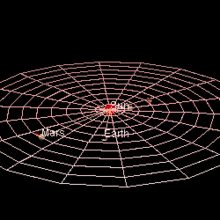


Mars has an orbit with a semimajor axis of 1.524 astronomical units (228 million km) (12.673 light minutes), and an eccentricity of 0.0934.[1][2] The planet orbits the Sun in 687 days[3] and travels 9.55 AU in doing so,[4] making the average orbital speed 24 km/s.
The eccentricity is greater than that of every other planet except Mercury, and this causes a large difference between the aphelion and perihelion distances—they are respectively 1.666 and 1.381 AU.[5]
- ^ Simon, J.L.; Bretagnon, P.; Chapront, J.; Chapront-Touzé, M.; Francou, G.; Laskar, J. (February 1994). "Numerical expressions for precession formulae and mean elements for the Moon and planets". Astronomy and Astrophysics. 282 (2): 663–683. Bibcode:1994A&A...282..663S.
- ^ Jean Meeus, Astronomical Formulæ for Calculators. (Richmond, VA: Willmann-Bell, 1988) 99. Elements by F. E. Ross
- ^ In ephemeris days of 86 400 seconds. The sidereal and anomalistic years are 686.980 days and 686.996 days long, respectively. (About a 20 minute difference). The sidereal year is the time taken to revolve around the Sun relative to a fixed reference frame. More precisely, the sidereal year is one way to express the rate of change of the mean longitude at one instant, with respect to a fixed equinox. The calculation shows how long it would take for the longitude to change 360 degrees at the given rate. The anomalistic year is the time span between successive perihelion or aphelion passages. This may be calculated in the same manner as the sidereal year, but the mean anomaly is used.
- ^ Jean Meeus, Astronomical Algorithms (Richmond, VA: Willmann-Bell, 1998) 238. The formula by Ramanujan is accurate enough.
- ^ Williams, David (2018). "Mars Fact Sheet". NASA Goddard Space Flight Center. Archived from the original on 17 March 2020. Retrieved 22 March 2020.; Mean Anomaly (deg) 19.412 = (Mean Longitude (deg) 355.45332) – (Longitude of perihelion (deg) 336.04084)
 This article incorporates text from this source, which is in the public domain.
This article incorporates text from this source, which is in the public domain.